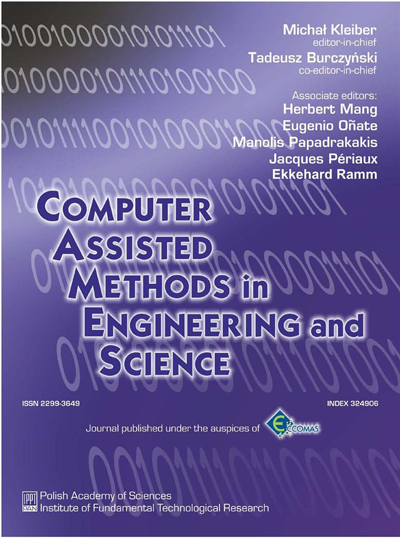Multibody approach in suspension system optimization
Abstract
In this paper an approach of optimization of suspension system parameters is described. Taking into consideration the stiffness and damping coefficients of springs and shock absorbers of a heavy road transport vehicle semitrailer, process of adjusting those values has been undertaken by means of the response surface methodology and a desirability function application, supported by the sensitivity computations. Two different methods of constructing metamodels: Kriging and polynomial regression have been tested and compared with a set of results obtained from the numerical multibody dynamic analysis. The objective of the undertaken efforts was to minimize the loads in the crucial points of the structure, identified as the high-risk failure areas. A number of simulations have been carried out under the set of different load cases, specially established to represent a wide range of operating conditions possible to be met during the vehicle life cycle.
Keywords
multibody modeling, lightweight structures, response surface method, dynamics of multibody system,References
[1] P. Om Agrawal, A.A. Shabana. Dynamic analysis of multibody systems using components models. Computers & Structures, 21: 6, 1303–1312, 1985.[2] T. Amago. Sizing Optimization Using Response Surface Method in FOA. R&D Review of Toyota CRDL, 37: 1, 2002.
[3] E.K. Bender, D.C. Karnopp, I.L. Paul. On the Optimisation of Vehicle Suspensions Using Random Process Theory. ASME Paper No. 67-TRAN-12, 1967.
[4] D.W. Blue, B.T. Kulakowski. Computer Optimization of Heavy Truck Suspension Parameters. Road Transport Technology Proceedings of the International Symposium on Heavy Vehicle Weights and Dimensions, Int Forum Road Transp Technol, Ontario, Canada, p. 517–523, 1995.
[5] E. Del Castillo, D.C. Montgomery, D.R. McCarville. Modified Desirability Functions for Multiple Response Optimization. Journal of Quality Technology, 28: 3, 1996.
[6] D.J. Cole, D. Cebon. Modification of a Heavy Vehicle Suspension to Reduce Road Damage. Proceedings of the Institution of Mechanical Engineers, Part D: Journal of Automobile Engineering, 209: 183–194, 1995.
[7] D.J. Cole, D. Cebon. Truck Suspension Design to Minimize Road Damage. Proceedings of the Institution of Mechanical Engineers, Part D: Journal of Automobile Engineering, 210: 95–107, 1996.
[8] G. Derringer. A Balancing Act: Optimizing a Product’s Properties. Quality Progress, 27(6): 51–58, 1994.
[9] G. Derringer, R. Suich. Simultaneous Optimization of Several Response Variables. Journal of Quality Technology, 12: 214–219, 1980.
[10] M. El-Madany. A Procedure for Optimization of Truck Suspensions. Vehicle System Dynamics, 16: 5–6, 297–312, 1987.
[11] FEMtools® Model Updating Theoretical Manual Version 3.2. Dynamic Design Solutions NV (DDS), 49–59, 2007.
[12] A. Gallina. Response Surface Methodology as a tool for analysis for uncertainty in structural dynamics. Ph.D. Thesis, AGH – University of Science and Technology, 2009.
[13] A. Gallina, A. Martowicz, T. Uhl. Robustness analysis of a car windscreen using response surface techniques. Finite Elements in Analysis and Design, 47(1): 46–54, 2011.
[14] E. Harrington. The Desirability Function. Industrial Qual. Control, pp. 494–498, 1965.
[15] J.C. Heltona, F.J. Davisb, J.D. Johnson. A comparison of uncertainty and sensitivity analysis results obtained with random and Latin hypercube sampling. Reliability Engineering and System Safety, 89: 305–330, 2005.
[16] R. Jin, W. Chen, T.W. Simpson. Comparative studies of metamodeling techniques under multiple modeling criteria. Structural and Multidisciplinary Optimization, 23: 1–13, 2001.
[17] K.J. Kim, D.K.J. Lin. Simultaneous optimization of mechanical properties of steel maximizing exponential desirability functions. Journal of the Royal Statistical Society: Series C, 49: 3, 311–325, 2000.
[18] A. Martowicz, P. Kurowski, T. Uhl, G. Lasko. Robust design optimisation of the FE model of rail vehicle. Paper 1654 in Proceedings of WCSMO-8: 8th World Congress on Structural and Multidisciplinary Optimization, Lisbon, Portugal, June 1–5, 2009.
[19] A. Martowicz, P. Kurowski, T. Uhl, G. Lasko. Design optimization of multibody model of rail vehicle supported by Response Surface Method. Rodrigues H. et al. [Eds.]. Proceedings of EngOpt 2010 – 2nd International Conference on Engineering Optimization, September 6–9, Lisbon, 2010.
[20] R.H. Myers, D.C. Montgomery D.C. Response Surface Methodology. Process and Product Optimization Using Designed Experiments (second edition). John Wiley & Sons, New York, NY, 2002.
[21] A. Saltelli, M. Ratto, T. Andres, F. Campolongo, J. Cariboni, D. Gatelli, M. Saisana, S. Tarantola. Global Sensitivity Analysis. The Primer. John Wiley & Sons, Ltd, Chichester, UK, 2008.
[22] T.W. Simpson. Comparison of Response Surface and Kriging Models in the Multidisciplinary Design of an Aerospike Nozzle. ICASE Report No. 98–16, 1998.
[23] T.W. Simpson, D.K.J. Lin, W. Chen. Sampling Strategies for Computer Experiments: Design and Analysis. International Journal of Reliability and Applications, 2001.
[24] T.W. Simpson, J.D. Peplinski, P.N. Koch, J.K. Allen. On the Use Of Statistics In Design and the Implications for Deterministic Computer Experiments. Proceedings of DETC’ 97, Sep. 14–17, Sacramento, California, 1997.
[25] T. Uhl. Computer aided manufacturing and design: Computer Assisted Identification of Mechanical Structures (in Polish). WNT, Warsaw, 1997.
[26] G.G. Wang, S. Shan. Review of Metamodeling Techniques in Support of Engineering Design Optimization. ASME Transactions, Journal of Mechanical Design, 2006.




